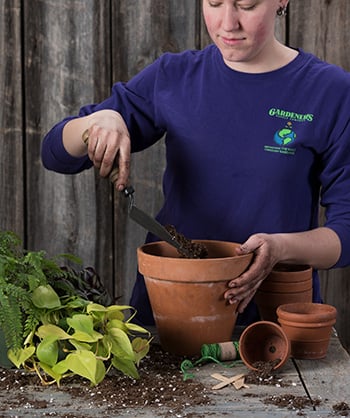Recharge Your Houseplants Through Repotting

Many houseplants will benefit from repotting every other year or so. Start with a bag of good potting mix. Look for a mix that contains shredded sphagnum peat moss, blended with vermiculite or perlite, such as our Transplant Mix. Adding a little compost (10 to 20 percent) will improve moisture retention and provide essential nutrients. Plants that require sharp drainage, such as rosemary, cactus and succulents, will benefit from the addition of some builder's sand. Sand can be up to 20 percent of the mix.
Cover your work area — floor, table or countertop — with plastic or an old sheet. Remember that making a bit of a mess is part of the fun. Put the dry soil mix into a potting tray, bucket, old dishpan or one of our Tubtrugs. Add warm water, a little at a time, and use your hands to fluff the soil as it absorbs moisture.
Collect any houseplants that look stressed or too large for their pots.
- Tip the first plant out of its old pot. You may need to loosen the soil from the sides of the pot with a table knife, or try putting your hand over the base of the plant, turning the pot over and tapping the pot gently.
- Once the plant is out of the pot, loosen the roots and use a scissors to clip off any roots that are dead or damaged. Healthy roots are usually light in color and fleshy inside. Clip off any dead or broken branches, too.
- If the plant is bigger than you want it to be, just tease away or cut back the parts of the plant that are least vigorous.
Most plants can be returned to the same pot they came out of. If the pot was completely filled with roots (no soil left), and you haven't divided the plant, it should probably go into a pot that's an inch or two larger in diameter. If you are returning the plant to the same pot, remove any old soil from the pot and scrub off any mineral deposits that may have accumulated.
- Put an inch or two of soil mix in the bottom of the pot.
- Place the plant back in the pot. In most cases, you should not bury the plant any deeper than it was growing originally.
- Add soil around the sides of the root ball and firm very gently (don't press too hard).
- Water thoroughly with room-temperature water to settle the soil and fill any air pockets.
Place newly repotted plants out of direct sunlight for a week. This gives the plants a chance to get readjusted. Hold off on fertilizer for at least two weeks. The plants will be healthiest if they can re-establish their root systems before starting to put on new top growth or set new flower buds. When it's time to fertilize, use a water-soluble form, such as Plant Health Care for Seedlings/Houseplants.
Print this Article:
Get the Dirt
Stay up to date on new articles and advice. Please fill out the information below.
